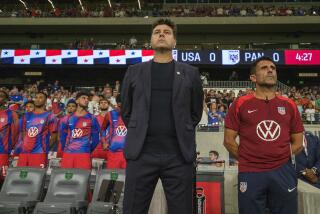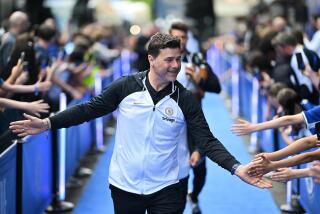The 3-6-1 Adds Up to Zero for U.S.
LYON, France — A month ago, Steve Sampson was sitting in the coffee shop of a San Diego hotel, sliding packets of sugar around on the table, enthusiastically showing a reporter the wonderful flexibility of the 3-6-1 formation.
The Cobi Jones packet dropped back here, the Ernie Stewart packet circled around over there, and just like that, the U.S. penalty area was clogged with seven defenders.
Then the Claudio Reyna packet moved this way, the Frankie Hejduk packet went that way and--voila!--the 3-6-1 was ready to attack the opposition net.
Those versatile sugar packets were unstoppable that morning, up to any challenge, primed for any assignment--Total Football next to a teacup, immune to every assault this side of tooth decay.
It looked good on Formica. But if this had been a truly realistic demonstration, the silverware would have sprung to life, started cursing in German and begun hacking and slashing the sugar packets until all Sampson had left was white powder sifting through his fingers.
Some good ideas are destined to remain just that, as the flesh-and-blood Germans proved until it hurt Monday night at Parc des Princes. In their 2-0 demolition of Team USA, the Germans exposed every weakness in the 3-6-1--so many, in fact, Sampson ought to be thinking seriously about 86ing the 3-6-1 before the Iran match Sunday.
The fundamental premise behind the 3-6-1--which aligns three defenders with six midfielders and only one striker--is to overload the midfield so that the opposition cannot control the ball. It also allows for two holding midfielders, who provide a defensive shield for the back line, and two wingbacks, who shuttle up and down the field, attacking on this play, defending on the next.
Sampson likes the formation because:
* If you believe, as Sampson does, that the U.S. roster is glutted with quality midfielders, the 3-6-1 gets half a dozen of them on the field at the same time.
If you believe, as the rest of the world does, that defense is the weak link of the U.S. team, the 3-6-1 keeps all but three defenders on the American bench.
* It utilizes only one striker, which, according to Sampson, “answers the long-standing question, ‘Who is going to partner with Eric Wynalda?’ The answer is: There is no partner.”
That was not a plus against the Germans, who, with only one American forward to worry about, easily clamped down on Wynalda and denied him the ball. For the first 45 minutes, the United States might as well have been playing with 10 men, since Wynalda spent his time mostly walking or standing still.
At least he had a good view of Andy Moller’s goal.
Sampson replaced Wynalda with Roy Wegerle in the 63rd minute, claiming he wanted “more energy out of that position.”
Translation: He wanted someone willing to run on occasion. Sampson has long been critical of Wynalda’s work ethic, but pairing Wynalda with a more industrious forward, Joe-Max Moore, say, lessens that deficiency.
But in a 3-6-1, with no such support, Wynalda has to fend for himself, which wasn’t happening against Germany.
“I had three of the best defenders in the world on my back,” Wynalda said, in defense of his touching the ball only once in the first half.
In any formation using only one striker, ideally that striker plays well with his back to the goal, being physical enough to bump and grind with world-class defenders and strong at heading the ball. England’s Alan Shearer, who banged in a header Monday with a Tunisian fullback bear-hugging him from behind, comes immediately to mind.
Sampson, however, lacks a true back-to-the-goal striker. Wynalda is a wanderer, Wegerle a plugger. Brian McBride comes closest--of the U.S. forwards, he’s the best at heading the ball--but he didn’t get off the bench Monday.
With the striker shut off, the 3-6-1 becomes too dependent on the midfield to manufacture scoring chances--and quite simply, it doesn’t produce enough.
Since its debut in a 3-0 victory over Austria in late April, the 3-6-1 has generated only two goals in four games--both in a 2-0 triumph over Kuwait. Even those three goals in Vienna are deceptive. The last two were scored in the 89th and 90th minutes, after the Austrian defense had already cashed it in.
When the 3-6-1 has to attack--as it did after Germany scored in the ninth minute--it requires at least four midfielders to push forward, leaving the three-man back line vulnerable to a counter-attack--which the Germans exploited to perfection in the second half, cashing in on Jurgen Klinsmann’s goal.
Finally, the 3-6-1, as it appeared Monday, does not take advantage of one Team USA’s supposed strengths--international experience. Of Sampson’s 11 starters against Germany, only four--Wynalda, Jones, Stewart and sweeper Thomas Dooley--had previously appeared in World Cup play.
Brian Maisonneuve had previously started two games for the U.S. national team before opening the World Cup alongside Chad Deering at holding midfielder. Deering was twice as experienced on the international level--four starts before being thrown to the Germans.
Mike Burns--earnest, hard-working utility man, but a utility man nevertheless--started a World Cup match against Germany. Tab Ramos, veteran of 77 international games for the United States, played only the final 21 minutes. Marcelo Balboa and Alexi Lalas, with more than 200 U.S. appearances combined, did not get off the bench.
A shift back to the old 4-4-2 system is not the perfect remedy, but considering the imprecise pieces Sampson is working with, it is the best option available.
David Regis, the best thing to happen to the U.S. team in months, has yet to be tried in a 4-4-2. Sure, Lalas and Balboa are slow, but put one of them at stopper in front of Dooley sweeping, with Regis and Eddie Pope flanking him on either side, and the support looks able enough.
Intangibles come into play in the World Cup--leadership, presence on the field, the ability to watch a German fullback clean out Claudio Reyna and step up the next moment to return fire. Lalas and Balboa can provide that. And they both can head the ball out of their own penalty area on a corner kick--a skill that can no longer be under-appreciated after Monday’s game.
Next, find a way to use Ramos for than 21 minutes. Maybe as a withdrawn forward behind Wynalda, to make better use of Ramos’ passing and long-range shooting skills.
One game into the World Cup is not the time to panic, nor is it the time to surrender. It is time to adjust, to make course corrections, to go with what works and forget the rest.
It is time to put the sugar packets away.
*
GOOD ENOUGH: Italy wasn’t perfect but it was effective in a 3-0 victory over Cameroon that left it atop Group B standings. C5
*
THE LATE SHOW: Austria again scored a late goal to salvage a 1-1 draw, and Chile again had victory snatched away. C5







